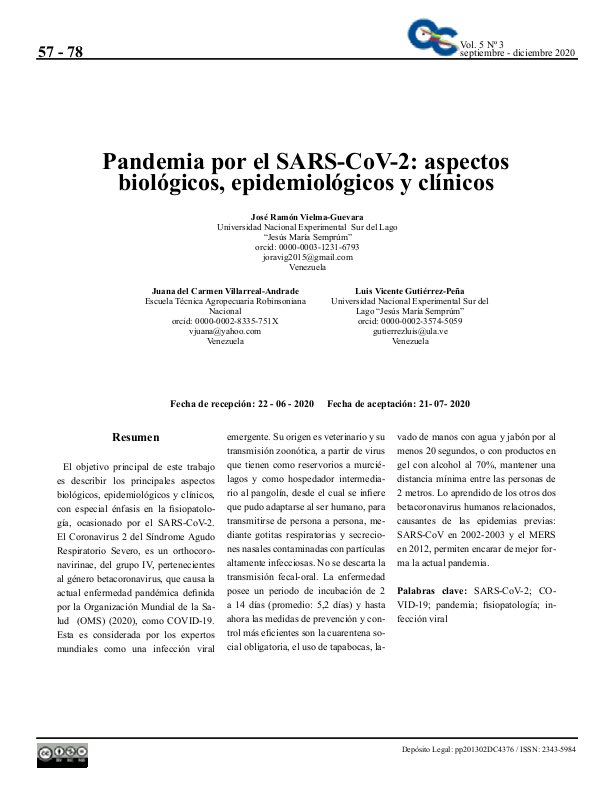Pandemia por el SARS-CoV-2: aspectos biológicos, epidemiológicos y clínicos
Palabras clave:
SARS-CoV-2; COVID-19; pandemia; fisiopatología; infección viralResumen
El objetivo principal de este trabajo es describir los principales aspectos biológicos, epidemiológicos y clínicos, con especial énfasis en la fisiopatología, ocasionado por el SARS-CoV-2.El Coronavirus 2 del Síndrome Agudo Respiratorio Severo, es un orthocoronavirinae, del grupo IV, pertenecientes al género betacoronavirus, que causa la actual enfermedad pandémica definida por la Organización Mundial de la Salud (OMS) (2020), como COVID-19. Esta es considerada por los expertos mundiales como una infección viral emergente. Su origen es veterinario y su transmisión zoonótica, a partir de virus que tienen como reservorios a murciélagos y como hospedador intermediario al pangolín, desde el cual se infiere que pudo adaptarse al ser humano, para transmitirse de persona a persona, mediante gotitas respiratorias y secreciones nasales contaminadas con partículas altamente infecciosas. No se descarta la transmisión fecal-oral. La enfermedad posee un periodo de incubación de 2 a 14 días (promedio: 5,2 días) y hasta ahora las medidas de prevención y control más eficientes son la cuarentena social obligatoria, el uso de tapabocas, lavado de manos con agua y jabón por al menos 20 segundos, o con productos en gel con alcohol al 70%, mantener una distancia mínima entre las personas de 2 metros. Lo aprendido de los otros dos betacoronavirus humanos relacionados, causantes de las epidemias previas: SARS-CoV en 2002-2003 y el MERS en 2012, permiten encarar de mejor forma la actual pandemia.
Descargas
Citas
Ahn, D.G., Shin, H.J., Kim, M.H., Lee, S., Kim, H.S., Myoung, J., Kim, B.T, and Kim, S.J. (2020). Current Status of Epidemiology, Diagnosis, Therapeutics, and Vaccines for Novel Coronavirus Disease 2019 (COVID-19). Journal of Microbiology and Biotechnology, 30 (3), 313-324.
Almeida, J.D. and Tyrrell, D. A. J. (1967). The Morphology of Three Previously Uncharacterized Human Respiratory Viruses that Grow in Organ Culture, Journal of General Virology, 1, 2, Available from. Recuperado en: https://doi.org/10.1099/0022-1317-1-2-175.
Backer, J.A., Klinkenberg, D. and Wallinga, J. (2020). Incubation period of 2019 novel coronavirus (2019-nCoV) infections among travellers from Wuhan, China, 20-28 January. Eurosurveillance, 25, 5, Recuperado en: https://www.eurosurveillance.org/content/10.2807/1560-7917.ES.2020.25.5.2000062
Chacín-Bonilla, L., Vielma, J.R. and Bonilla, E. (2014). Should Melatonin be Considered a Complementary or Alternative Therapy against Parasitic Infections? Epidemiology Open Access, 4, e117. Recuperado en: doi:10.4172/2161-1165.1000e117.
Channappanavar, R. and Perlman, S. (2017). Pathogenic human coronavirus infections: causes and consequences of cytokine storm and immunopathology. Seminars in Immunopathology, 39, 529-539.
Chen, N., Zhou, M., Dong, X., Qu, J., Gong, F., Han, Y., Qiu, Y., Wang, J., Liu, Y., Wei, Y., Xia, J., Yu, T., Zhang, X. and Zhang, L. (2020). Epidemiological and clinical characteristics of 99 cases of 2019 novel coronavirus pneumonia in Wuhan, China: a descriptive study, Lancet (London, England), 395, 507-513.
Chu, H., Zhou, J., Wong, B.H.Y., Li, C.C., Chan, J.F.W., Cheng, Z.S., Yang, D., Wang, D., Lee, A.C.Y., Li, C.C., Yeung, M.L., Cai, J.P., Chan, I.H.Y., Ho, W.K., To, K.K.W., Zheng, B.J., Yao, Y., Qin, C. and Yuen, K.Y. (2016). Middle east respiratory syndrome coronavirus efficiently infects human primary T lymphocytes and activates the extrinsic and intrinsic apoptosis pathways. Journal of Infectious Disease, 213, 904-914.
Du, L., Yang, Y., Zhou, Y., Lu, L., Li, F., Jiang, S. (2017). MERS-CoV spike protein: a key target for antivirals. Expert Opinion in Therapeutics Targets, 21 (2), 131-43.
Fan, C., Li, K., Ding, Y., Lu, W.L. and Wang, J. (2020). ACE2 Expression in Kidney and Testis May Cause Kidney and Testis Damage After 2019-nCoV Infection. medRxiv, doi: Recuperado en: https://doi.org/10.1101/2020.02.12.20022418
Fehr, A.R. and Perlman S. (2015). Coronaviruses: an overview of their replication and pathogenesis. Methods in Molecular Biology, 1282,1-23.
Fu, Y., Cheng, Y. and Wu, Y. (2020). Understanding SARS-CoV-2-Mediated Inflammatory Responses: From Mechanisms to Potential Therapeutic Tools. Virologica Sinica, 1-6, doi: 10.1007/s12250-020-00207-4.
González-Jaramillo, V., González-Jaramillo, N., Gómez-Restrepo, C., Palacio-Acosta, C.A., Gómez-López, A. y Oscar H. Franco, O.H. (2020). Proyecciones de impacto de la pandemia COVID-19 en la población colombiana, según medidas de mitigación. Datos preliminares de modelos epidemiológicos para el periodo del 18 de marzo al 18 de abril de 2020. Revista de Salud Pública (Bogotá), 22, 1-6.
Gorbalenya, A.E., Baker, S.C., Baric, R.S., de Groot, R.J., Drosten, C., Gulyaeva, A.A., Haagmans, B.L., Lauber, C., Leontovich, A.M., Neuman, B.W., Penzar, D., Perlman, S., Poon, L.L.M., Samborskiy, D., Sidorov, I.A., Sola, I. and Ziebuhr, J. (2020). Severe acute respiratory syndrome-related coronavirus: the species and its viruses- a statement of the coronavirus study group. BioRxiv, 20200207, 937862.
Guan, G.W., Gao, L., Wang, J.W., Wen, X.J., Mao, T.H., Peng, S.W., Zhang, T., Chen, X.M. and Lu, F.M. (2020). Exploring the mechanism of liver enzyme abnormalities in patients with novel coronavirus-infected pneumonia. Zhonghua Gan Zang Bing Za Zhi, 28, E002.
Hamre, D. and Procknow, J.J. (1966). A New Virus Isolated from the Human Respiratory Tract. Experimental Biology and Medicine. Recuperado en: https://doi.org/10.3181/00379727-121-30734
Huang, C., Wang, Y., Li, X., Ren, L., Zhao, J., Hu, Y., Zhang, L., Fan, G., Xu, J., Gu, X., Cheng, Z., Yu, T., Xia, J., Wei, Y., Wu, W., Xie, X., Yin, W., Li, H., Liu, M., Xiao, Y., Gao, H., Guo, L., Xie, J., Wang, W., Jiang, R., Gao, Z., Jin, Q., Wang, J. and Cao, B. (2020). Clinical features of patients infected with 2019 novel coronavirus in Wuhan, China. Lancet (London England), 395, 497-506.
Imai, Y., Kuba, K. and Penninger, J.M. (2008). The discovery of angiotensin-converting enzyme 2 and its role in acute lung injury in mice. Experimental Physiology, 93, 543-548.
Jin, Y., Yang, H., Ji, W., Wu, W., Chen, S., Zhang, W. and Duan, G. (2020). Virology, Epidemiology, Pathogenesis, and Control of COVID-19. Viruses, 12, 372, Recuperado en: DOI:10.3390/v12040372.
Kalyanaraman, B. (2013). Teaching the basics of redox biology to medical and graduate students: Oxidants, antioxidants and disease mechanisms. Redox Biology, 1, 244-257.
Lai, C.C., Shi, T.P., Ko, W.C., Tang, H.J. Hsueh, P.R. (2020). Severe acute respiratory syndrome coronavirus 2 (SARS-CoV-2) and coronavirus disease-2019 (COVID-19): The epidemic and the challenges. International Journal Antimicrobiological Agents, 105924, Available from. Recuperado en: https://doi.org/10.1016/j.ijantimicag.2020.105924.
Li, F. (2016). Structure, function, and evolution of coronavirus spike proteins. Annuary Review Virology, 3 (1), 237-261.
Li, Q., Guan, X., Wu, P., Wang, X., Zhou, L., Tong, Y., Ren, R., Leung, K.S.M., Lau, E.H.Y., Wong, J.Y., Xing, X., Xiang, N., Wu, Y., Li, C., Chen, Q., Li, D., Liu, T., Zhao, J., Liu, M., Tu, W., Chen, C., Jin, L., Yang, R., Wang, Q., Zhou, S., Wang, R., Liu, H., Luo, Y., Liu, Y., Shao, G., Li, H., Tao, Z., Yang, Y., Deng, Z., Liu, B., Ma, Z., Zhang, Y., Shi, G., Lam, T.T.Y., Wu, J.T., Gao, G.F., Cowling, B.J., Yang, B., Leung, G.M. and Feng, Z. (2020). Early transmission dynamics in Wuhan, China, of novel Coronavirus-infected pneumonia. New England of Journal of Medicine, 382, 1199-1207.
Liu, Y., Li, J. and Feng, Y. (2020). Critical care response to a hospital outbreak of the 2019-nCoV infection in Shenzhen, China. Critical Care, 24, 56.
Lu, R., Zhao, X., Li, J., Niu, P., Yang, B., Wu, H., Wang, W., Song, H., Huang, B., Zhu, N., Bi, Y., Ma, X., Zhan, F., Wang, L., Hu, T., Zhou, H., Hu, Z., Zhou, W., Zhao, L., Chen, J., Meng, Y., Wang, J., Lin, Y., Yuan, J., Xie, Z., Ma, J., Liu, W.J., Wang, D., Xu, W., Holmes, E.C., Gao, G.F., Wu, G., Chen, W., Shi, W. and Tan, W. (2020 a). Genomic characterisation and epidemiology of 2019 novel coronavirus: implications for virus origins and receptor binding. Lancet, 395, 565-574
Lu, X., Zhang, L., Du, H., Zhang, J., Li, Y.Y., Qu, J., Zhang, W., Wang, Y., Bao, S., Li, Y. and for the Chinese Pediatric Novel Coronavirus Study Team.(2020 b). SARS-CoV-2 Infection in Children. New England of Journal of Medicine, 382:1663-1665, Recuperado en: DOI: 10.1056/NEJMc2005073
Masters, P.S. (2006). The molecular biology of coronaviruses. Advances in Virus Research, 66, 193-292.
Meyer, N.J. and Christie, J.D. (2013). Genetic heterogeneity and risk of acute respiratory distress syndrome. Seminars of Respiratory and Critical Care Medicine, 34, 459-474.
Murray, R.K., Bender, D.A., Botham, K.M., Kennelly, P.J., Rodwell, V.W. y Weil, P.A. (2012). Harper. Bioquímica ilustrada. Mexico; McGraw-Hill Interamericana Editores,
Paraskevis, D., Kostaki, E.G., Magiorkinis, G., Panayiotakopoulos, G., Sourvinos, G. and Tsiodras, S. (2020). Full-genome evolutionary analysis of the novel corona virus (2019-nCoV) rejects the hypothesis of emergence as a result of a recent recombination event. Infections, Genetics and Evolution, 79, 104212.
Raj, V.S., Mou, H., Smits, S.L., Dekkers, D.H., Muller, MA., Dijkman, R., Muth, D., Demmers, J.A.A., Zaki, A., Fouchier, R.A.M., Thiel, V., Drosten, C., Rottier, P.J.M., Osterhaus, A.D.M.E., Bosch, B.J. and Haagmans, B.L. (2013). Dipeptidyl peptidase 4 is a functional receptor for the emerging human coronavirus-EMC. Nature, 495 (7440), 251-254.
Shanmugaraj, B., Siriwattananon, K., Wangkanont, K., and Phoolcharoen, W. (2020). Perspectives on monoclonal antibody therapy as potential therapeutic intervention for Coronavirus disease-19 (COVID-19). Asian Pacific Journal of Allergy and Immunology, 10-18.
Şimşek Yavuz, S. and Ünal, S. (2020). Antiviral treatment of COVID-19. Turkish Journal of Medical Sciences, 50, 611-619.
Sola, I., Almazan, F., Zuniga, S. and Enjuanes, L. (2015). Continuous and discontinuous RNA synthesis in coronaviruses. Annual Review of Virology, 2, 265-288.
Song, Z., Xu, Y., Bao, L., Zhang, L., Yu, P., Qu, Y., Zhu, H., Zhao, W., Han, Y. and Qin, C. (2019). From SARS to MERS, thrusting coronaviruses into the spotlight. Viruses, 11 (1), 59.
Thompson, B.T., Chambers, R.C. and Liu, K.D. (2017). Acute Respiratory Distress Syndrome. New England of Journal of Medicine, 377, 562-572.
Varela, Y.Y., Labrador, I. y Araque, M. (2019). Fenotipo hipermucoviscoso de Klebsiella pneumoniae hipervirulenta: Lo nuevo de un viejo enemigo. Avances en Biomedicina, 8, 21-30.
Vielma, J.R. y Concepción, J.L. (2005). Diagnóstico de la enfermedad de Chagas utilizando como antígeno la proteína recombinante de 24 kDa (Pgr24). [Trabajo especial de grado], Maestría en Biología Celular, Posgrado Interdisciplinario en Biología Celular, Facultad de Ciencias, Universidad de Los Andes, Mérida, 155 p.
Vielma, J.R., Bonilla, E., Chacín-Bonilla, L., Mora, M., Medina-Leendertz, S. and Bravo, Y. (2014). Effects of melatonin on oxidative stress, and resistance to bacterial, parasitic, and viral infections: A review. Acta Tropica, 137, 31-38.
Vielma, J.R., Picón, D., Gutiérrez, L.V. and Lara, N.D. (2018). Pathophysiology of osteoporosis: genes, oxidative stress and immunopathogeny. A qualitative systematic review Avances en Biomedicina, 7 (2), 100-111.
Wertheim, J.O.., Chu, D.K.W., Peiris, J.S.M., Kosakovsky Pond, S.L.K and Leo L. M. (2013). A Case for the Ancient Origin of Coronaviruses. Journal of Virology, 87 (12), 7039-7045
WHO. (2020 a). Coronavirus disease (COVID-19) technical guidance: Laboratory testing for 2019-nCoV in humans. Recuperado en : https://www.who.int/emergencies/diseases/novelcoronavirus2019/technical/guidance/laboratory-guidance
WHO. (2020 b). Statement on the meeting of the International Health Regulations, 2005. Emergency Committee regarding the outbreak of novel coronavirus (2019-nCoV). Available . Recuperado en: https://www.who.int/news-room/detail/23-01-2020-statement-on-the-meeting-of-the-international-health-regulations-(2005)-emergency-committee-regarding-the-outbreak-of-novel-coronavirus-(2019-ncov)
Wu, Z. and McGoogan, J.M. (2020). Characteristics of and important lessons from the coronavirus disease 2019 (COVID-19) outbreak in China: summary of a report of 72 314 cases from the Chinese center for disease control and prevention. Journal of American Medicine Association, 2020. Recuperado en:https://doi.org/10.1001/jama.2020.2648
Xu, Z., Shi, L., Wang, Y., Zhang, J., Huang, L., Zhang, C., Liu, S., Zhao, P., Liu, H., Zhu, L., Tai, Y., Bai, C., Gao, T., Song, J., Xia, P., Dong, J., Zhao, J. and Wang, F.S. (2020). Pathological findings of COVID-19 associated with acute respiratory distress syndrome. Lancet Respiratory Medicine, 8, 420-422.
Yang, M. (2020). Cell Pyroptosis, a Potential Pathogenic Mechanism of 2019-nCoV Infection. Available at SSRN. Recuperado en: https://ssrn.com/abstract=3527420 or http://dx.doi.org/10.2139/ssrn.3527420
Yang, X., Yu, Y., Xu, J., Shu, H., Xia, Ja., Liu, H., Yongran Wu, Y., Zhang, L., Yu, Z., Fang, M., Yu, T., Wang, Y., Pan, S., Zou, X., Yuan, S., Shang, Y. (2020). Clinical course and outcomes of critically ill patients with SARS-CoV-2 pneumonia in Wuhan, China: a single-centered, retrospective, observational study. Lancet Respiratory Medicine, pii: S2213-2600(20)30079-5.
Zhai, P., Ding, Y., Wu, X., Long, J., Zhong, Y. and Li, Y. (2020). The epidemiology, diagnosis and treatment of COVID-19. International Journal of Antimicrobial Agents, 55, 105955.
Zhang, J.J., Dong, X., Cao, Y.Y., Yuan, Y.D., Yang, Y.B., Yan, Y.Q., Cezmi A., Akdis, C.A. and Gao, Y.D. (2020 a). Clinical characteristics of 140 patients infected with SARS-CoV-2 in Wuhan, China. Allergy, doi: 10.1111/all.14238.
Zhang, R., Wang X., Ni, L., Di, X., Ma. B, Niu, S., Liu, C. and Reiter, R.J. (2020 b). COVID-19: Melatonin as a potential adjuvant treatment. Life Sciences, 250, 117583.
Zhou, F., Yu, T., Du, R., Fan, G., Liu, Y., Liu, Z., Xiang, J., Wang, Y., Song, B., Gu, X., Guan, L., Wei, Y., Li, H., Wu, X., Xu, J., Tu, S., Zhang, Y., Chen, H. and Cao, B. (2020). Clinical course and risk factors for mortality of adult inpatients with COVID-19 in Wuhan, China: a retrospective cohort study. Lancet, 395, 1054-1062.
Zhu, N., Zhang, D., Wang, W., Li, X., Yang, B., Song. J., Zhao, X., Huang, B., Shi, W., Lu, R., Niu, P., Zhan, F., Ma, X., Wang, D., Xu, W., Wu, G., Gao, G.F., Tan, W. and China Novel Coronavirus Investigating and Research Team (2020). A novel coronavirus from patients with pneumonia in China, 2019. New England Journal Medicine, 382, 727–733.
Zou, X., Chen, K., Zou, J., Han, P., Hao, J. and Han, Z. (2020). The single-cell RNA-seq data analysis on the receptor ACE2 expression reveals the potential risk of different human organs vulnerable to Wuhan 2019-nCoVinfection. Frontiers in Medicine, 1-8.

Descargas
Publicado
Cómo citar
Número
Sección
Licencia

Esta obra está bajo una licencia internacional Creative Commons Atribución-SinDerivadas 4.0.







